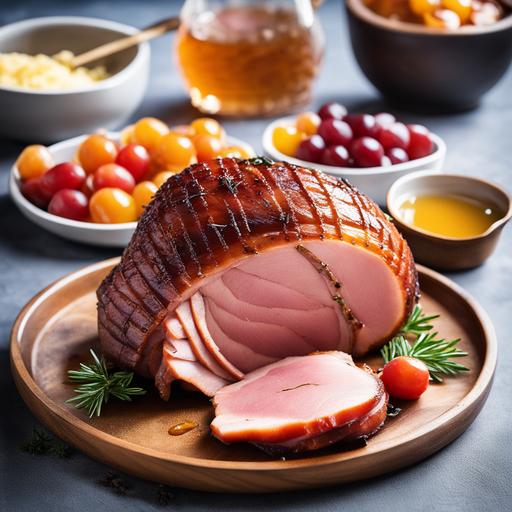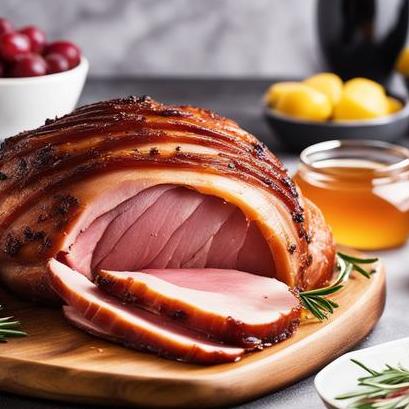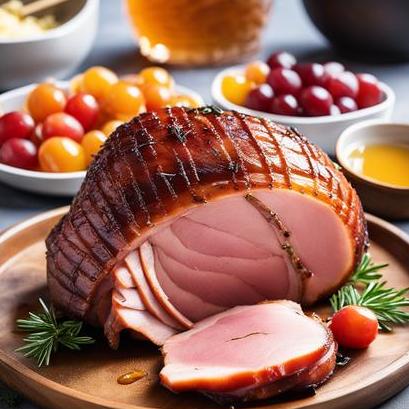
Honey Glazed Ham Oven Recipe: A Comprehensive Guide
Are you looking to impress your family and friends with a succulent and flavorful centerpiece for your holiday feast? Look no further than the delectable honey glazed ham. With its sweet and savory flavor profile, aromatic glaze, and tender meat, this dish is sure to be a crowd-pleaser. In this comprehensive guide, we will explore the food science behind a perfect honey glazed ham, share culinary details, provide tips and variations, and guide you through the entire process from selection to serving. So let’s dive in and create a memorable culinary masterpiece!
Food Science: The Maillard Reaction
The key to achieving a beautiful honey glazed ham lies in understanding the science behind the Maillard reaction. This chemical reaction occurs when proteins and sugars are heated, resulting in browning, flavor development, and the creation of aromatic compounds. It is this reaction that gives the ham its irresistible aroma and depth of flavor.
When the ham is glazed with a sticky, sweet mixture containing sugars, such as honey, they caramelize during the cooking process. This caramelization not only enhances the visual appeal of the ham but also adds a delicious sweetness to complement the savory flavor.
Culinary Details: Selecting and Cleaning the Ham
Before diving into the preparation, it’s essential to select the right ham for your recipe. There are two main types of hams available: fully cooked and partially cooked. Both types are suitable for glazing; however, they require slightly different cooking techniques.
For this recipe, we recommend using a fully cooked ham. Look for a bone-in ham that weighs between 8 and 10 pounds. The bone contributes to the overall flavor and moistness of the meat. Additionally, ensure the ham has a layer of fat, as it will help protect the meat during the cooking process.
Once you have your ham, it’s important to clean it thoroughly. Rinse it under cold water to remove any excess brine or glaze residue. Pat it dry with a paper towel, ensuring that it’s completely moisture-free before proceeding with the glazing process.
Preparation: Tips and Tricks

Preparing a honey glazed ham is all about layers of flavor. Here are some tips and tricks to ensure that your ham is succulent, flavorful, and beautifully caramelized:
- Score the ham: Using a sharp knife, score the surface of the ham in a diamond pattern. This allows the glaze to penetrate through the fat layer and into the meat, creating pockets of flavor.
- Glazing masterpiece: Prepare a delectable glaze by combining honey, brown sugar, Dijon mustard, and a hint of warm spices such as cinnamon and cloves. The honey provides the sweetness, while the mustard adds a tangy kick. The warm spices add depth and complexity to the glaze.
- Apply glaze generously: Using a brush, generously apply the glaze all over the scored and fat-covered surface of the ham. Ensure that every nook and cranny is covered, allowing the glaze to seep into the scores and impart its delicious flavors.
- Baste regularly: To ensure that the ham remains moist and flavorful, make sure to baste it with the glaze every 20-30 minutes during the cooking process. This allows the flavors to deepen while keeping the surface glossy and caramelized.
Variations: Exploring Flavor Profiles

While the traditional honey glazed ham is a classic favorite, there are several variations you can explore for a unique twist. Here are a few ideas to experiment with:
- Maple Mustard Glaze: Replace the honey with maple syrup and swap the Dijon mustard with whole grain mustard. This variation offers a subtle smokiness and a robust flavor.
- Citrus-infused Glaze: Add a burst of freshness by incorporating citrus zest and juice into the glaze. Orange, lemon, or lime can bring a lively, tangy element to the ham.
- Spicy Pineapple Glaze: For those who enjoy a touch of heat, combine crushed red pepper flakes with pineapple juice in the glaze. This combination offers a perfect balance of sweet, spicy, and tangy flavors.
Feel free to experiment with different glaze variations to suit your personal taste preferences. The versatility of the honey glazed ham allows for endless creativity and exploration.
Doneness Checks: Ensuring Perfectly Cooked Ham

To ensure your honey glazed ham is perfectly cooked, it’s essential to monitor the internal temperature using a meat thermometer. The desired internal temperature should reach 140-145 degrees Fahrenheit (60-63 degrees Celsius). Insert the thermometer into the thickest part of the meat, avoiding contact with the bone.
Overcooking the ham will result in dryness and toughness, while undercooking may lead to an unpleasantly chewy texture. Aim for a juicy and tender consistency by achieving the ideal internal temperature.
Recipe: Honey Glazed Ham

Now that you are fully equipped with the knowledge of honey glazed ham, let’s proceed with a tried-and-true recipe:
Ingredients:
- 1 fully cooked bone-in ham (8-10 pounds)
- 1 cup of honey
- 1/2 cup of brown sugar
- 1/4 cup of Dijon mustard
- 1 teaspoon of ground cinnamon
- 1/2 teaspoon of ground cloves
Instructions:
- Preheat your oven to 325 degrees Fahrenheit (163 degrees Celsius).
- Place the ham on a rack in a roasting pan, with the fat side facing up.
- Score the surface of the ham in a diamond pattern, approximately 1/2 inch deep.
- In a bowl, whisk together the honey, brown sugar, Dijon mustard, cinnamon, and cloves until well combined.
- Generously brush the glaze mixture all over the ham, ensuring that it seeps into the scores.
- Place the ham in the preheated oven and roast for approximately 15-18 minutes per pound, basting with the glaze every 20-30 minutes.
- Use a meat thermometer to check the internal temperature. Once it reaches 140-145 degrees Fahrenheit (60-63 degrees Celsius), remove the ham from the oven.
- Allow the ham to rest for 10-15 minutes before carving. This allows the juices to redistribute throughout the meat, ensuring moistness and tenderness.
- Carve and serve your honey glazed ham as the star of your holiday feast!
Perfecting your Honey Glazed Ham
While the recipe shared above guarantees a delicious honey glazed ham, don’t be afraid to experiment and make it your own. Enjoy this culinary adventure, exploring different flavor profiles and techniques. Remember to have fun and embrace the joy of cooking!
Whether you are hosting a festive gathering, celebrating a special occasion, or simply treating your loved ones to a memorable meal, the honey glazed ham is a timeless classic that never fails to impress. So gather your ingredients, tie your apron, and embark on a culinary journey that will leave everyone craving for more. Happy cooking and bon appétit!
Sources
FAQS On Honey Glazed Ham Oven Recipe
What Is The Best Type Of Ham To Use For A Honey Glazed Ham?
The best type of ham to use for a honey glazed ham is a bone-in, spiral-cut ham. This allows the glaze to seep into the slices and infuse the meat with flavor.
How Do I Prepare The Ham Before Applying The Honey Glaze?
Before applying the honey glaze, it’s important to let the ham come to room temperature for about 30 minutes. Then, score the surface of the ham in a crisscross pattern to help the glaze penetrate the meat.
How Should I Make The Honey Glaze For The Ham?
To make the honey glaze, combine honey, brown sugar, Dijon mustard, and a splash of apple cider vinegar in a saucepan over medium heat. Cook the mixture until the sugar is dissolved and the glaze has thickened slightly.
How Do I Apply The Honey Glaze To The Ham?
Once the ham is scored, brush the honey glaze all over the surface of the ham, making sure to get the glaze in between the slices. You can also use a baster to drizzle the glaze into the slices for maximum flavor.
How Long Do I Need To Bake The Honey Glazed Ham In The Oven?
Place the ham on a rack in a roasting pan, cover it with foil, and bake in a preheated oven at 325°F. Plan on baking the ham for approximately 10-12 minutes per pound, or until it reaches an internal temperature of 140°F. Be sure to baste the ham with the glaze every 30 minutes for a deliciously caramelized finish.


